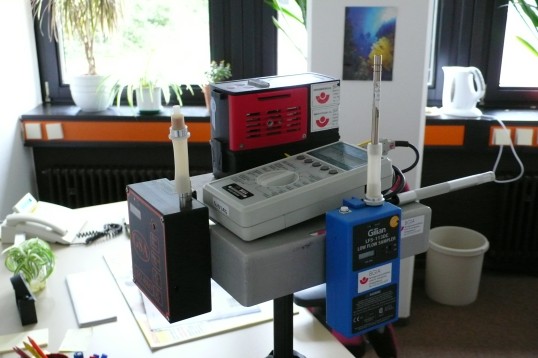- Elektromagnetic Fields
- Indoor workplaces
- Practical Solutions: Ergonomics
- Practical solutions: Hazardous substances
- Practical solutions: Noise
- Practical solutions: Machine safety
- Practical solutions: Personal Protective Equipment
Measurement of chemical exposures

Indoor workplace with measurement device
Source: IFA
Indoor pollutants have numerous sources, whose emission characteristics differ significantly. There are
- continuous sources, which can emit pollutants over a long period (e.g. building materials or furnishings), and
- intermittent sources, which can cause short-term peak exposure to pollutants (e.g. cleaning agents).
When selecting a measuring strategy, it is important to know the emission characteristics of the pollutant source. For pollutants from continuous sources, passive samplers are particularly useful whilst active sampling systems make more sense for pollutants emitted from discontinuous sources.
A key problem in indoor pollutant measurement is the variety of possible pollutants and source characteristics. Information about the nature and location of sources and about potential pollutants should therefore be gathered, if possible, when carrying out hazardous substance investigations, in addition to information about emission characteristics. These findings can then be used to determine where measurements should be taken, for how long, how frequently and how many.
If the investigations do not yield any concrete evidence concerning the hazardous substances, indicative measurements can be performed based on the Determination and evaluation of chemical contamination of indoor workplace atmospheres (PDF, 473 KB). This system covers volatile organic compounds, aldehydes and carbon dioxide
For download

Report "Indoor workplaces"
